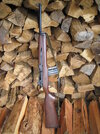CoalCrackerAl
Member
I got the stock one out. To check if it was a .060 bushing. Reason is because im planing on a mini 30. And theirs is supposed to be .080 factory. I was planing to try my mini 14 one as a reduced gas bushing.

It's a comon accurizing tweak for the Mini-14 and Mini-30. The gas system is quite different than that of the M1A.I don't have a Mini 14 but hot rodding the gas system on my M1A isn't good for it.
Has anyone witnessed a cracked Ruger. If Im lying im dying but I've been in the closet with my love of shooting mini's and never cracked any part. Now I put a buffer on my original from 1988 and it wouldn't function.Too much force through the gas port beats the rifle up. I don't want to crack metal parts. Reducing the area of the gas port is the best solution. I also use a Wilson Combat 1911 buffer pad. Heavier-rate springs can also be had but I have not found that necessary with the smaller gas bushings.
Sweet rifle !!! When you get older you'll find ways to stay out of the mud and stay dryWhen I bought my 5800 series,I messed about with the gas system changing the bushings. In the end,I changed it back to the factory stock gas bushing. If it sends the brass into orbit and dents the case I don't care. I have more AR .223/5.56 fired brass than I can shake a stick at. I want that rifle to fire and cycle like an AK when its mud caked,wet or any other adverse condition. I believe that why Ruger uses the larger orifice.
View attachment 1197066
Very different systems. The mini-14 is a lot closer to an M1 Carbine mechanically. And this is the opposite of hot-rodding. They’re REDUCING the amount of gas entering the system (which is notoriously over-gassed from the factory) and prolonging the life of parts.I don't have a Mini 14 but hot rodding the gas system on my M1A isn't good for it.
I'm 72 in a couple of months and live on a ranch in coastal Oregon....Near on impossible to stay out of the rain and mud.When you get older you'll find ways to stay out of the mud and stay dry
Send some this way!!!I'm 72 in a couple of months and live on a ranch in coastal Oregon....Near on impossible to stay out of the rain and mud.
